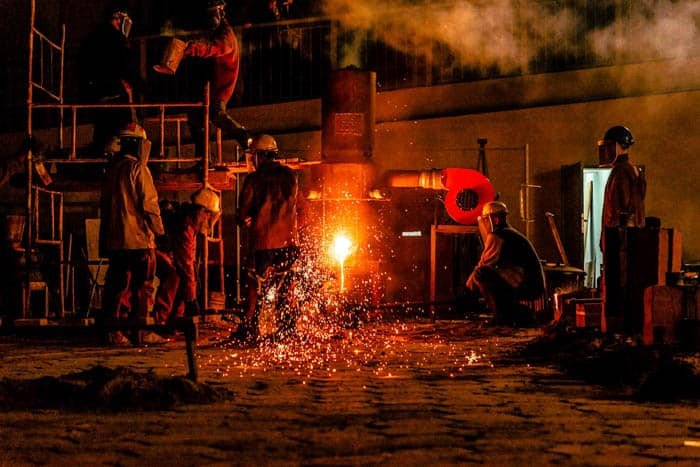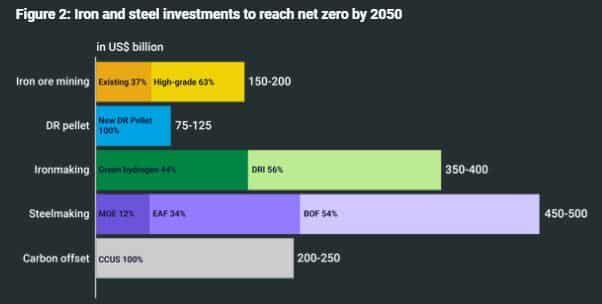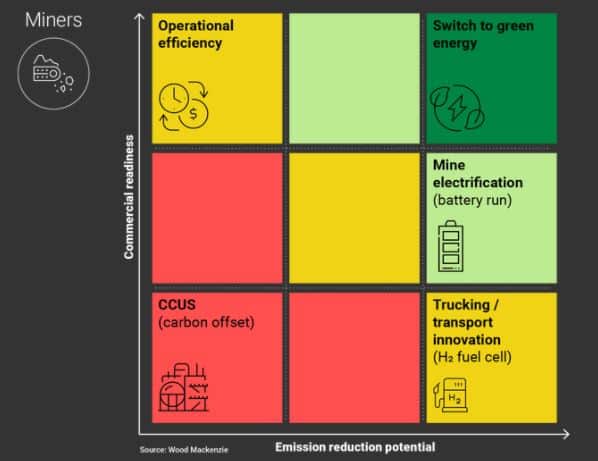Bringing the iron and steel industry to net zero by 2050 requires $1.4 trillion of investment, $250 billion of which is for carbon credits, according to Wood Mackenzie.
Currently, iron and steel production together release a total of 3.4 billion tonnes of carbon each year. This represents 7% of total global emissions.
- To meet the global demand for steel by 2050, the industry must produce 2.2 billion tonnes of steel.
The industry emits a lot of carbon and is one of the most difficult one to decarbonize.
Wood Mackenzie analyzed in its latest report, “Pedal to the Metal: Iron and steel’s $1.4 trillion shot at decarbonisation”, the what, when, and how of reaching net zero pathway.
Remarking on the report, lead author Malan Wu said that:
“Decarbonising the steel industry is a big task. To meet Wood Mackenzie’s 1.5°C accelerated energy transition scenario by 2050, steel emissions must reduce by 90% from current levels. There is an urgent need to act now to decarbonise the iron and steel sectors. Business as usual is no longer sustainable.”
Footing the Bill to Reach Net Zero
The 1.5°C pathway requires 2050 steel emissions to decline by over 90% from current levels. But the analysis assumes only a 33% decline in steel emissions from current levels.
The report shows the urgency to act now to bring the industry to net zero emissions. It also presents an investment opportunity for the operators as the sector decarbonizes.
- The largest factor for the industry to be successful in its climate goal is to switch to Electric Arc Furnaces (EAFs).
But that’s only one part of the $1.4 trillion investment opportunity for industry players.
Other measures needed include:
- Exploring new high-grade iron ore mines
- Greening current steelmaking routes,
- Adopting new technologies (EAF, DRI, etc.)
- Developing a hydrogen ecosystem for steel, and
- Buying carbon credits
Mining companies will have to cut their operational emissions and invest in new green steel technologies. These include high-grade mines and DR pellet capacities.
Decarbonizing the industry also calls for shifting to clean energy use. This is equal to about 2,000 GW of renewable energy generation capacity (that’s ⅔ of current global capacity).
Now add developing the hydrogen technology to this…
- The net zero goal needs about 50 million tonnes of green hydrogen per year.
Here’s the breakdown of the trillion investment.
Carbon Credits (Offsets) are a Must for Iron and Steel
As upgrades and green technologies are still not enough, the iron and steel industry needs to buy up to $250 billion in carbon offsets, also called carbon credits. They’re necessary to tackle emissions that can’t yet be reduced.
Carbon credits represent certain amounts of carbon reduced or removed from the air, either through nature or technology.
In the case of iron and steel, CCUS (Carbon Capture, Use, and Storage) is a technological option to curb emissions.
The present supply of CCUS is limited and is in its nascent stage. The current global CCUS pipeline is 14x the amount currently being captured of 63 million tonnes per year (Mtpa).
But emission reduction efforts from other industries are also calling for this measure.
The industry must capture and store 470 Mt of carbon to reach its emission target in 2050. And that calls for a $200 – $250 billion investment in CCUS.
Forged Blueprint: What Miners and Steelmakers Can Do
SO, what should iron ore miners and steelmakers do to solve the industry’s net zero equation?
The following images provide some clarity…
Achieving net zero will entail a revolutionary transformation of iron and steel, and its value chain. But a collaboration among key industry players will help drive green action.




